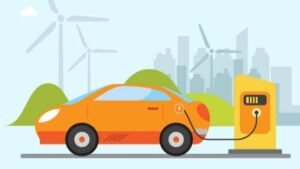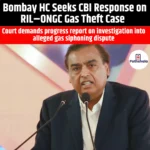Supreme Court Urges Government to Boost Electric Vehicle Adoption
|
General Studies Paper II: Environmental Pollution & Degradation, Government Policies & Interventions |
Why in News?
Recently, amid rising air pollution in Delhi, the Supreme Court highlighted the urgent need to accelerate Electric Vehicle adoption. The court urged the government to take concrete steps, weaving sustainable mobility into city planning and daily commuting habits.
Air Pollution Crisis in India
- India faces a serious air pollution problem in its cities mainly. In 2024 the country’s average PM 2.5 concentration reached about 50.6 µg/m³, nearly ten times the annual guideline of 5 µg/m³ as per IQAir report.
- Several major urban centres such as New Delhi frequently record Air Quality Index (AQI) values in the “severe” or “hazardous” range during winter months. The densely populated National Capital Region thus often becomes a hotspot of smog and polluted air that lingers for weeks. These elevated pollutant levels consistent across years in many Indian metropolises.
- Urban air pollution in India stems from multiple interlinked sources. Vehicular emissions, especially in large cities, produce significant amounts of fine particles and nitrogen oxides. Industrial outputs and coal‑fired power plants contribute further to airborne contaminants.
- Agricultural residue burning in neighbouring states during the post‑harvest season adds a seasonal spike of smoke and particulates, particularly affecting Delhi and the Indo‑Gangetic plain.
- Dust from construction, open burning of waste, and domestic use of biomass fuels in peri‑urban areas exacerbate the burden of pollutants. The combined result yields persistently high levels of harmful air pollutants such as PM₂.₅, PM₁₀, NO₂ and SO₂.
- Exposure to poor air quality has immediate and long‑term effects on human health. In India, more than 2.1 million deaths each year are attributed to air pollution according to the 2024 “State of Global Air” data. A study found that every 10 µg/m³ increase in PM₂.₅ leads to an 8.6 % rise in mortality.
- Residents in polluted cities face increased risk of respiratory ailments such as asthma, chronic obstructive pulmonary disease (COPD), lung cancer, as well as cardiovascular disorders like stroke and heart attacks.
- In Delhi the winter season often brings air quality index values above 400 and extremely high particulate concentrations when crop stubble burning meets temperature inversions and urban emissions. Among the world’s 30 most polluted cities, 17 are located in India; Delhi remains the most polluted capital city globally. The density of population, traffic congestion, industrial clusters and meteorological conditions combine to create localised pollution hotspots.
- Despite recognition of the crisis, several hurdles persist in mitigating the health impacts of urban air pollution. Monitoring networks remain less dense than needed, language and data gaps exist, and enforcement of pollution control norms is weak.
Supreme Court’s Intervention
- The Supreme Court of India recognised that citizens hold a fundamental right to a clean environment, as derived from Articles 14 and 21 of the Constitution. On 13 November 2025 the Court emphasised that the government’s inaction in reducing vehicular emissions undermines this right.
- In its recent order the Court directed the government to revisit the National Electric Mobility Mission Plan 2020 (NEMMP 2020) in view of the five years since its launch.
- The bench, comprising Justices Surya Kant and Joymalya Bagchi, asked that amendments reflect current technology, market realities, and the charging‑infrastructure gap.
- The Court also proposed that a pilot project be launched in a large metropolitan area to test EV adoption strategies before full‑scale national rollout.
- The Court suggested that a phase‑out of high‑emission petrol and diesel luxury vehicles could send a strong market signal in favour of electric mobility.
- The Court reasoned that targeting high‑end internal combustion engine vehicles first would minimally impact common citizens while beginning the transition.
How can Electric Vehicles Transform a Climate-Resilient Future?
- Electric Vehicles (EVs) offer a powerful way to cut greenhouse gas (GHG) emissions, support clean energy, and build climate‑resilient cities.
- EVs help lower carbon emissions because they produce no tailpipe CO₂. Studies in India show that battery electric vehicles (BEVs) emit up to 38% less CO₂-equivalent per kilometre than similar internal combustion engine vehicles.
- According to a government analysis, by FY 2030, EV adoption could cut around 28 million tonnes of CO₂ in India, assuming continued growth in EV usage and renewables in the power grid.
- A study by TERI estimates that a complete EV transition in 44 Indian cities (with populations over 1 million) would reduce 61 million tonnes of CO₂ over five years (2030–2035).
- EV charging can be powered increasingly by renewable energy, helping decarbonise both the transport and power sectors. As India’s grid becomes greener, the environmental gains from EVs will grow.
- EVs are more energy efficient than conventional vehicles: they convert a large share of grid electricity to motion, reducing energy waste and fossil‑fuel dependence.
- As more EVs charge from clean electricity, they help stabilize demand for renewables, supporting a sustainable energy ecosystem.
- By eliminating exhaust emissions, EVs reduce key pollutants like nitrogen oxides (NOx) and particulate matter, which are major contributors to urban air pollution.
- EVs also help reduce noise pollution because their electric motors operate much more quietly than internal combustion engines.
- Widespread EV adoption reduces dependence on imported crude oil. Less reliance on fossil-fuel imports strengthens national energy security and shields the economy from global oil price shocks.
- A shift to EVs aligns with wider climate goals, helping cities meet their net-zero and sustainable development targets by cutting transport-sector emissions in a decisive way.
National Electric Mobility Mission Plan (NEMMP) 2020
-
- About: The NEMMP 2020 was launched by the Government of India under the Department of Heavy Industry (DHI) in 2013, as a long-term roadmap for electric and hybrid vehicle adoption. The mission targets a cumulative 6–7 million electric or hybrid vehicles on Indian roads by 2020.
- Objectives:
-
-
- Fuel Savings: NEMMP envisages a large saving in crude oil consumption — roughly 2.2–2.5 million tonnes by meeting its EV deployment goals.
- Emissions Reduction: It aims to reduce greenhouse gas emissions and air pollution by replacing higher‑emission ICE vehicles with xEVs.
- Industrial Growth: The plan promotes domestic manufacturing of EVs and components (such as motors and batteries), to build an indigenous value chain and reduce import dependence.
- Technology Development: It supports R&D investment into battery technology, systems integration, testing, and power electronics.
- Infrastructure Development: A strong push is planned for charging infrastructure across cities, highways, and transport hubs.
- Sustainable xEVs: Its core aim is to foster a shift in mobility from conventional Internal Combustion Engine (ICE) vehicles to more sustainable xEVs (hybrid + electric), in order to reduce dependence on fossil fuels, cut emissions, and strengthen energy security.
- Demand-side Incentives: Through schemes like FAME India, buyers receive subsidies or discounts to reduce the upfront cost of EVs.
- Regulatory Measures: The plan encourages policy tools such as reduced GST on EVs, tax benefits, and permitting reforms.
-
- Challenges:
-
- Target Shortfall: The envisioned target of 6–7 million EVs by 2020 was not realized. A parliamentary panel noted that by August 2022, only about 1.4 million EVs were on Indian roads.
- High Upfront Costs: EVs remain more expensive than ICE vehicles, largely due to battery costs.
- Charging Infrastructure Gaps: Public charging stations are unevenly distributed, and rural or semi-urban areas lack adequate coverage.
- Grid Constraints: Scaling EV charging requires robust electricity infrastructure. The grid’s capacity and stability are under pressure.
- Battery Technology Limitations: Existing batteries face constraints such as limited range, long charging times, and heavy reliance on imported raw materials.
- Policy Uncertainty: Long-term certainty is missing. Frequent shifts in subsidies or incentives can discourage manufacturers and consumers.
|
Government Initiatives to Promote EVs in India
|
|
Also Read: India Emerges as a Leading Contributor to Global Greenhouse Emissions |









